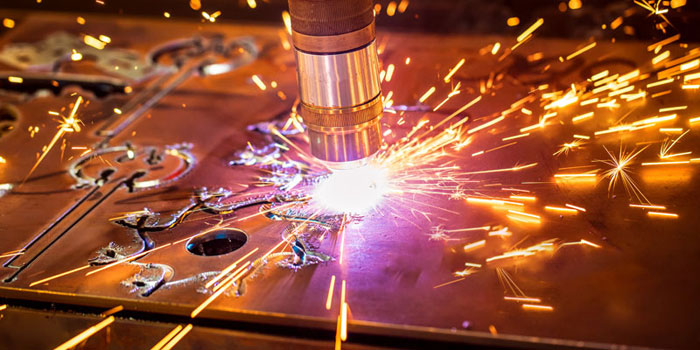

It is no longer a problem for laser cutting machines to cut steel plates below 10mm thick. But if you want to cut thicker steel plates, you often resort to high-power lasers with an output power exceeding 5kW, and the cutting quality is also significantly reduced. Due to the high cost of high-power laser equipment and its output laser mode is not conducive to laser cutting, traditional laser cutting methods do not have advantages in cutting thick plates. There are the following technical difficulties in cutting thick plates with metal laser cutting machines:
1. It is difficult to maintain the quasi-steady combustion process. In the actual cutting process of the metal laser cutting machine, the thickness of the plate that can be cut through is limited, which is closely related to the inability to stably burn the iron at the cutting edge. For the combustion process to continue, the temperature at the top of the slit must reach the ignition point. The energy released by the iron-oxygen combustion reaction alone cannot actually ensure that the combustion process continues. On the one hand, it is because the kerf is continuously cooled by the oxygen flow from the nozzle, which reduces the temperature of the cutting front; on the other hand, the ferrous oxide layer formed by combustion covers the surface of the workpiece, hindering the diffusion of oxygen. When the concentration of oxygen decreases At a certain point, the combustion process will be extinguished. When traditional converging beams are used for laser cutting, the area where the laser beam acts on the surface is very small. Due to the high power density of the laser, not only in the area of laser radiation, the surface temperature of the workpiece reaches the ignition point, but also due to heat conduction, a wider The region reaches the ignition temperature. The diameter of the oxygen flow acting on the surface of the workpiece is larger than the diameter of the laser beam. This shows that not only in the laser radiation area, a strong combustion reaction occurs, but also in the periphery of the laser beam irradiated spot. When cutting thick plates, the cutting speed is quite slow, and the iron oxide on the surface of the workpiece burns faster than the cutting head travels. After the combustion continues for a period of time, the combustion process is extinguished due to the decrease in the concentration of oxygen. Only when the cutting head travels to this position does the combustion reaction start again. The combustion process of the cutting front is carried out periodically, which will cause the temperature fluctuation of the cutting front and the quality of the cut will deteriorate.
2. It is difficult to maintain a constant oxygen purity and pressure in the thickness direction. When cutting thick plates with metal laser cutting machines, the decrease in oxygen purity is also an important factor affecting the quality of the incision. The purity of the oxygen flow has a strong influence on the cutting process. When the oxygen flow purity drops by 0.9%, the iron-oxygen combustion rate will drop by 10%; when the purity drops by 5%, the combustion rate will drop by 37%. The reduction of combustion rate will greatly reduce the energy input into the cutting seam during the combustion process, and reduce the cutting speed. At the same time, the content of iron in the liquid layer of the cutting surface increases, thereby increasing the viscosity of the slag, which makes it difficult to discharge the slag. Severe slag will appear in the lower part, making the quality of the cut unacceptable. In order to keep the cutting stable, it is required that the purity and pressure of the cutting oxygen flow in the thickness direction of the plate should be basically kept constant. In the traditional laser cutting process, common conical nozzles are often used, which can meet the requirements for thin plate cutting. However, when cutting thick plates, as the air supply pressure increases, shock waves are easily formed in the flow field of the nozzle. Shock waves have many hazards to the cutting process, reduce the purity of oxygen flow, and affect the quality of the cut.
Conduct in-depth cooperation with more than 500 foreign buyers, and maintains long-term cooperation with more than 1,000 domestic advanced manufacturing suppliers.








Write a Message